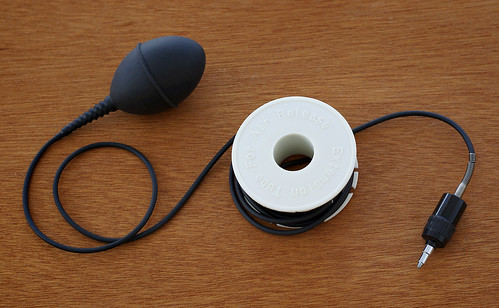Difference between revisions of "Squeeze bulb"
(new glossary page, pic) |
m (cross-link shutter release) |
||
| Line 11: | Line 11: | ||
A '''squeeze bulb''' is an alternative to a [[cable release]] as a method of triggering a shutter remotely, without touching the camera. Thus it avoids any jiggling which might degrade image sharpness. | A '''squeeze bulb''' is an alternative to a [[cable release]] as a method of triggering a shutter remotely, without touching the camera. Thus it avoids any jiggling which might degrade image sharpness. | ||
| − | Air pressure from squeezing the bulb passes through a length of tubing, and actuates a small piston; this in turn pushes a pin into a camera's shutter release and starts the exposure. The tubing may extend over quite a long distance (without the friction that would plague a cable release of that length), allowing the photographer to stand well away from the camera when needed. | + | Air pressure from squeezing the bulb passes through a length of tubing, and actuates a small piston; this in turn pushes a pin into a camera's [[shutter release]] and starts the exposure. The tubing may extend over quite a long distance (without the friction that would plague a cable release of that length), allowing the photographer to stand well away from the camera when needed. |
A pneumatic squeeze bulb was one of the earliest methods used to trigger a camera shutter, at a time when multi-second exposures were the norm. This is the origin of the "B" (bulb) setting found on many shutters—meaning, the shutter stays open as long as pressure is applied. | A pneumatic squeeze bulb was one of the earliest methods used to trigger a camera shutter, at a time when multi-second exposures were the norm. This is the origin of the "B" (bulb) setting found on many shutters—meaning, the shutter stays open as long as pressure is applied. | ||
Since the 1980s, many cameras began using an electronic switch to release their shutters. Today wired or infrared remote triggers have largely replaced the venerable squeeze bulb. | Since the 1980s, many cameras began using an electronic switch to release their shutters. Today wired or infrared remote triggers have largely replaced the venerable squeeze bulb. | ||
Latest revision as of 23:47, 2 February 2012

|
| A squeeze-bulb remote shutter release image by Voxphoto (Image rights) |
A squeeze bulb is an alternative to a cable release as a method of triggering a shutter remotely, without touching the camera. Thus it avoids any jiggling which might degrade image sharpness.
Air pressure from squeezing the bulb passes through a length of tubing, and actuates a small piston; this in turn pushes a pin into a camera's shutter release and starts the exposure. The tubing may extend over quite a long distance (without the friction that would plague a cable release of that length), allowing the photographer to stand well away from the camera when needed.
A pneumatic squeeze bulb was one of the earliest methods used to trigger a camera shutter, at a time when multi-second exposures were the norm. This is the origin of the "B" (bulb) setting found on many shutters—meaning, the shutter stays open as long as pressure is applied.
Since the 1980s, many cameras began using an electronic switch to release their shutters. Today wired or infrared remote triggers have largely replaced the venerable squeeze bulb.